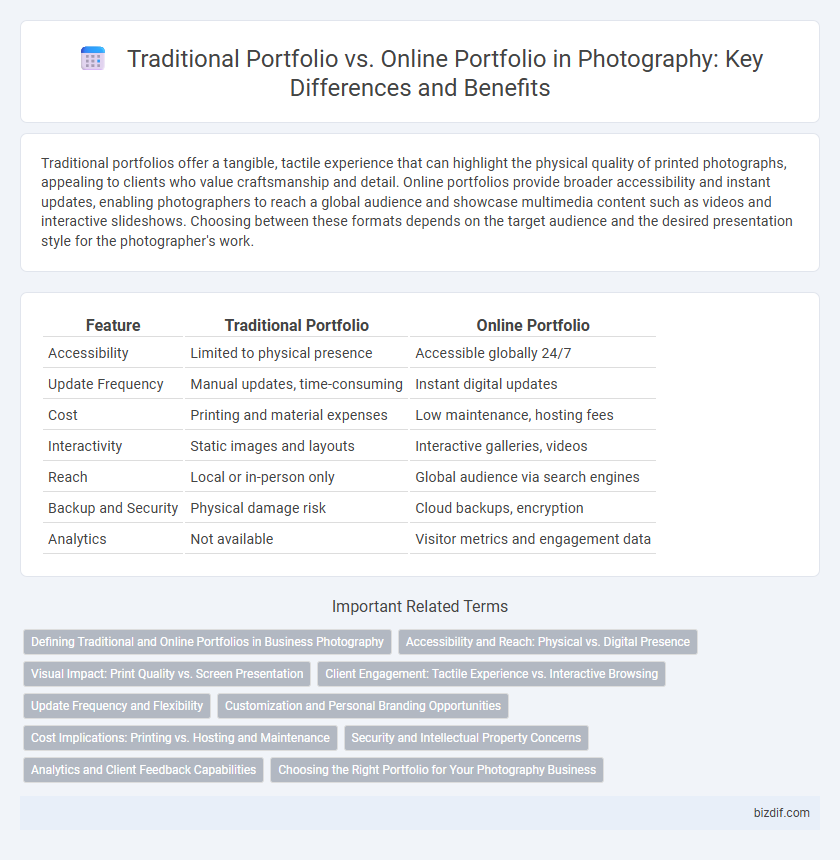Traditional portfolios offer a tangible, tactile experience that can highlight the physical quality of printed photographs, appealing to clients who value craftsmanship and detail. Online portfolios provide broader accessibility and instant updates, enabling photographers to reach a global audience and showcase multimedia content such as videos and interactive slideshows. Choosing between these formats depends on the target audience and the desired presentation style for the photographer's work.
Table of Comparison
| Feature | Traditional Portfolio | Online Portfolio |
|---|---|---|
| Accessibility | Limited to physical presence | Accessible globally 24/7 |
| Update Frequency | Manual updates, time-consuming | Instant digital updates |
| Cost | Printing and material expenses | Low maintenance, hosting fees |
| Interactivity | Static images and layouts | Interactive galleries, videos |
| Reach | Local or in-person only | Global audience via search engines |
| Backup and Security | Physical damage risk | Cloud backups, encryption |
| Analytics | Not available | Visitor metrics and engagement data |
Defining Traditional and Online Portfolios in Business Photography
Traditional portfolios in business photography consist of printed, physical collections of carefully curated images that showcase a photographer's skills, style, and range, often presented in high-quality binders or albums during in-person client meetings. Online portfolios utilize digital platforms or personal websites to display photographic work, offering broader accessibility, easy updates, and integration with social media and contact information. The choice between traditional and online portfolios depends on target audience engagement, convenience, and the evolving digital landscape in business photography marketing.
Accessibility and Reach: Physical vs. Digital Presence
Traditional photography portfolios offer tactile engagement, allowing clients to physically interact with prints and gauge image quality firsthand, but their reach is limited to in-person presentations. Online portfolios provide global accessibility, enabling photographers to showcase work instantly to a vast audience across devices and platforms, significantly expanding visibility and potential client base. The digital presence also supports easy updates and integration with social media, enhancing ongoing engagement and discovery opportunities.
Visual Impact: Print Quality vs. Screen Presentation
Traditional portfolios showcase photography through high-quality print materials that emphasize texture, color accuracy, and tangible depth, offering a tactile experience that can enhance visual impact in client meetings or exhibitions. Online portfolios utilize digital screens where images are optimized for various resolutions, brightness, and contrast settings, enabling vibrant presentation and immediate access across devices but sometimes limited by screen calibration and ambient lighting conditions. Photographers aiming for maximum visual impact often balance print quality's richness with the dynamic versatility of screen presentations to appeal to diverse audiences and professional contexts.
Client Engagement: Tactile Experience vs. Interactive Browsing
Traditional portfolios offer clients a tactile experience that allows them to physically interact with printed photographs, enhancing emotional connection through texture and material quality. Online portfolios provide interactive browsing features such as slideshows, zoom functions, and instant access to extensive galleries, enabling clients to explore a broader range of work conveniently. Client engagement in traditional settings relies on sensory immersion, while online platforms maximize accessibility and dynamic viewing options.
Update Frequency and Flexibility
Traditional portfolios often lack the flexibility needed for frequent updates, requiring physical alterations or complete reprinting to showcase new work, which can be time-consuming and costly. Online portfolios enable photographers to update their galleries instantly and effortlessly, accommodating new projects, client testimonials, or evolving styles with minimal effort. This digital adaptability enhances professional presentation and ensures portfolios remain current and relevant in a fast-paced photography market.
Customization and Personal Branding Opportunities
Traditional portfolios offer limited customization options, typically constrained by physical formats and materials, which restricts the ability to showcase a photographer's unique style and personal brand. Online portfolios provide extensive customization features, including dynamic layouts, multimedia integration, and brand-specific design elements that enhance visual storytelling and audience engagement. Leveraging platforms like Squarespace or Adobe Portfolio allows photographers to create a tailored digital presence that strengthens personal branding and attracts potential clients effectively.
Cost Implications: Printing vs. Hosting and Maintenance
Traditional photography portfolios incur costs for high-quality printing, materials, and physical storage, often requiring periodic updates that add to overall expenses. Online portfolios reduce upfront costs by eliminating printing but involve recurring fees for domain registration, hosting, and website maintenance. Photographers must weigh initial investment against ongoing expenses to determine the most cost-effective option for showcasing their work.
Security and Intellectual Property Concerns
Traditional photography portfolios reduce digital theft risks by keeping images offline and physically controlled, limiting unauthorized copying or distribution. Online portfolios offer broader exposure but require robust security measures like watermarking, encryption, and secure hosting to protect intellectual property from hacking or image misuse. Photographers must balance accessibility with safeguard strategies to maintain ownership rights and prevent infringement in digital environments.
Analytics and Client Feedback Capabilities
Traditional portfolios lack real-time analytics and comprehensive client feedback mechanisms, limiting photographers' ability to track viewer engagement and preferences. Online portfolios offer integrated tools such as visitor analytics, heatmaps, and interactive comment sections, enabling data-driven insights into client behavior and immediate feedback collection. These capabilities enhance portfolio optimization, helping photographers tailor their work presentation and marketing strategies to meet audience demands effectively.
Choosing the Right Portfolio for Your Photography Business
Selecting the right portfolio format significantly influences a photography business's reach and client engagement. Traditional portfolios offer tactile interaction and are ideal for in-person meetings, showcasing tangible print quality and craftsmanship. Online portfolios provide global accessibility, dynamic content display, and easy updates, making them essential for expanding digital presence and attracting diverse clients.
Traditional Portfolio vs Online Portfolio Infographic

 bizdif.com
bizdif.com